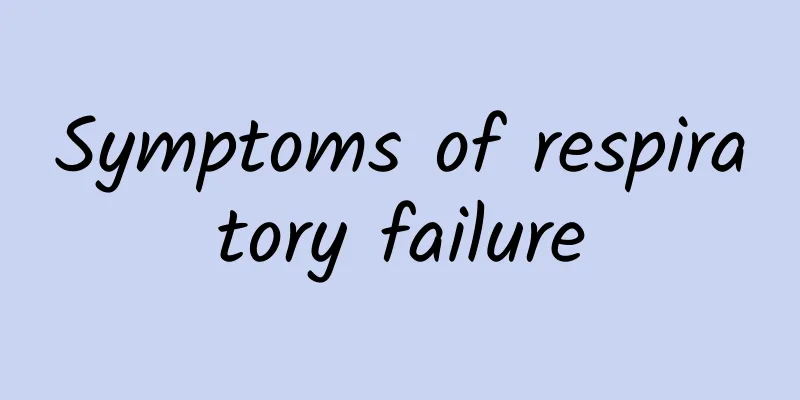Symptoms of respiratory failure

|
Respiratory failure is a disorder in the lung's gas exchange and ventilation functions, resulting in ineffective gas exchange. There are many causes of respiratory failure, including respiratory tract lesions and lung tissue lesions. Respiratory failure may also be caused by diseases of the respiratory muscles of the nerve center and its conduction system, chest wall lesions, and pulmonary vascular diseases. We can prevent respiratory failure as long as we reduce energy consumption and improve the nutritional status of our body functions. Exercising more can effectively prevent respiratory failure. The following are descriptions of the symptoms of respiratory failure. Causes 1. Respiratory tract lesions Bronchitis, bronchospasm, foreign bodies, etc. block the airway, causing insufficient ventilation. Uneven gas distribution leads to an imbalance in the ventilation/blood flow ratio, resulting in hypoxia and carbon dioxide retention. 2. Lung tissue lesions Pneumonia, severe pulmonary tuberculosis, emphysema, diffuse pulmonary fibrosis, adult respiratory distress syndrome (ARDS), etc. can cause a decrease in lung capacity, ventilation, and effective diffusion area, and an imbalance in ventilation/blood flow leading to pulmonary artery shunt, causing hypoxia and/or carbon dioxide retention. 3. Pulmonary vascular disease Pulmonary vascular embolism, pulmonary infarction, etc. cause part of the venous blood to flow into the pulmonary veins, resulting in hypoxia. 4. Thoracic lesions Such as chest trauma, surgical trauma, pneumothorax and pleural effusion, which affect the movement of the chest and the expansion of the lungs, resulting in reduced ventilation and uneven inhaled gas, affecting the ventilation function. 5. Diseases of the nerve center and its conduction system and respiratory muscles Cerebrovascular disease, encephalitis, brain trauma, drug poisoning, etc. directly or indirectly inhibit the respiratory center; poliomyelitis and polyneuritis cause muscle nerve junction blockade that affects conduction function; myasthenia gravis and others damage respiratory power and cause hypoventilation. Symptoms of respiratory failure 1. Classification (1) Classification by arterial blood gas analysis ① Type I respiratory failure with hypoxia and no CO2 retention, or with decreased CO2 (Type I) is seen in cases of ventilation dysfunction (ventilation/perfusion imbalance, diffusion function impairment and pulmonary arteriovenous shunt). ②Type II respiratory failure is caused by alveolar hypoventilation, resulting in O2 deficiency and CO2 retention. In simple hypoventilation, the degree of O2 deficiency and CO2 retention is parallel. If accompanied by impaired ventilation function, the O2 deficiency will be more serious. The condition can only be corrected by increasing alveolar ventilation and adding oxygen therapy when necessary. (2) Classification by disease course: The disease can be divided into acute and chronic. Acute respiratory failure refers to the sudden causes of the above five types of causes, which cause severe damage to ventilation or gas exchange function and sudden clinical manifestations of respiratory failure, such as cerebrovascular accident, drug poisoning inhibiting the respiratory center, respiratory muscle paralysis, pulmonary infarction, ARDS, etc. If not rescued in time, it will endanger the patient's life. Chronic respiratory failure is common in chronic respiratory diseases, such as chronic obstructive pulmonary disease, severe pulmonary tuberculosis, etc. The respiratory function damage gradually worsens. Although there is a lack of O2 or accompanied by CO2 retention, the body can still engage in daily activities through compensatory adaptation. 2. Symptoms In addition to the symptoms of the primary disease, the main manifestations are hypoxia and carbon dioxide retention, such as dyspnea, shortness of breath, mental and neurological symptoms, etc. When complicated by pulmonary encephalopathy, gastrointestinal bleeding may also occur. 3. Physical examination findings There may be cyanosis of the lips and nail beds, impaired consciousness, conjunctival congestion, edema, flapping tremor, and optic disc edema. Above we introduced what respiratory failure is. We know that respiratory failure is caused by many causes, but we also have ways to prevent respiratory failure. The above article introduced how to effectively prevent respiratory failure and introduced the symptoms of respiratory failure in detail. I hope it will be useful to everyone. |
<<: Functional dyspepsia precautions
>>: TCM Syndrome Differentiation of Stomach Qi Deficiency
Recommend
Lumbar spine always rings
I don't know if you have ever heard the sound...
What to do with spinal cord injury? Rehabilitation training for spinal cord injury
Spinal cord injury is a functional damage to the ...
Pain in the back of the head
Have we all experienced pain in the back of the h...
What's wrong with my boyfriend not being able to get hard?
When men reach a mature age, their genitals will ...
What should I do if I have tenosynovitis of the right middle finger?
The symptoms of finger tenosynovitis are very ser...
Skin scratching
Skin scratching, also known as artificial urticar...
How much water should be used to take Lingzhi spore powder?
Ganoderma lucidum spore powder is a very precious...
Can moxibustion be used to treat blood heat?
Blood heat is a relatively common symptom. The bl...
The exact location of Sanyinjiao
Sanyinjiao acupoint refers to the intersection of...
What are the advantages of TCM treatment of hemorrhoids?
Early treatment, early relief Ms. Zhao is a newsp...
Mycoplasma infection blood routine manifestations
Mycoplasma infection is a relatively common infec...
What to do if your ears and eyes bleed
Nowadays, many girls pierce their ears to wear so...
What causes itchy ears?
In autumn and winter, due to the dry climate, man...
The flesh on my body hurts when I touch it
Due to unreasonable work and rest schedules and u...
What causes dry and cracked upper lips?
As summer passes, the weather in autumn is bound ...









